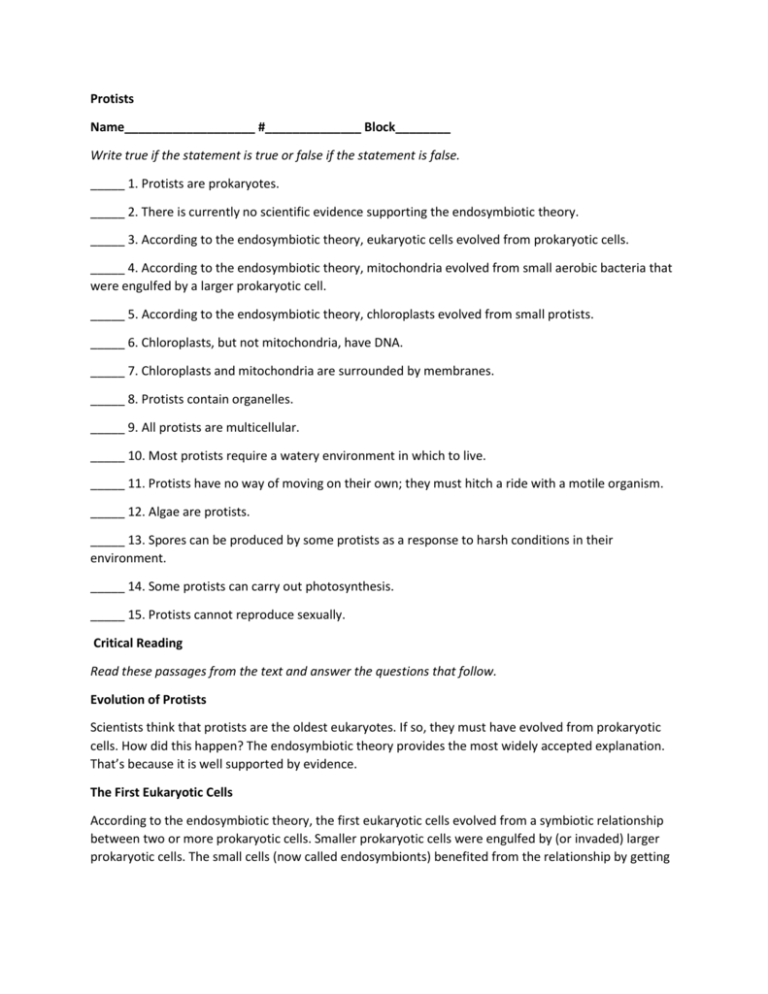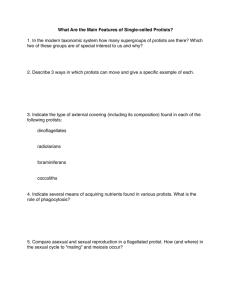Protists Packet - Phillips Scientific Methods
advertisement

Protists Name___________________ #______________ Block________ Write true if the statement is true or false if the statement is false. _____ 1. Protists are prokaryotes. _____ 2. There is currently no scientific evidence supporting the endosymbiotic theory. _____ 3. According to the endosymbiotic theory, eukaryotic cells evolved from prokaryotic cells. _____ 4. According to the endosymbiotic theory, mitochondria evolved from small aerobic bacteria that were engulfed by a larger prokaryotic cell. _____ 5. According to the endosymbiotic theory, chloroplasts evolved from small protists. _____ 6. Chloroplasts, but not mitochondria, have DNA. _____ 7. Chloroplasts and mitochondria are surrounded by membranes. _____ 8. Protists contain organelles. _____ 9. All protists are multicellular. _____ 10. Most protists require a watery environment in which to live. _____ 11. Protists have no way of moving on their own; they must hitch a ride with a motile organism. _____ 12. Algae are protists. _____ 13. Spores can be produced by some protists as a response to harsh conditions in their environment. _____ 14. Some protists can carry out photosynthesis. _____ 15. Protists cannot reproduce sexually. Critical Reading Read these passages from the text and answer the questions that follow. Evolution of Protists Scientists think that protists are the oldest eukaryotes. If so, they must have evolved from prokaryotic cells. How did this happen? The endosymbiotic theory provides the most widely accepted explanation. That’s because it is well supported by evidence. The First Eukaryotic Cells According to the endosymbiotic theory, the first eukaryotic cells evolved from a symbiotic relationship between two or more prokaryotic cells. Smaller prokaryotic cells were engulfed by (or invaded) larger prokaryotic cells. The small cells (now called endosymbionts) benefited from the relationship by getting a safe home and nutrients. The large cells (now called hosts) benefited by getting some of the organic molecules or energy released by the endosymbionts. Eventually, the endosymbionts evolved into organelles of the host cells. After that, neither could live without the other. Some of the endosymbionts were aerobic bacteria. They were specialized to break down chemicals and release energy. They evolved into the mitochondria of eukaryotic cells. Some of the small cells were cyanobacteria. They were specialized for photosynthesis. They evolved into the chloroplasts of eukaryotic cells. Evidence for Endosymbiotic Theory Many pieces of evidence support the endosymbiotic theory. For example: Mitochondria and chloroplasts contain DNA that is different from the DNA found in the cell nucleus. Instead, it is similar to the circular DNA of bacteria. Mitochondria and chloroplasts are surrounded by their own plasma membranes, which are similar to bacterial membranes. New mitochondria and chloroplasts are produced through a process similar to binary fission. Bacteria also reproduce through binary fission. The internal structure and biochemistry of chloroplasts is very similar to that of cyanobacteria. Questions 1. What does the endosymbiotic theory attempt to explain? 2. What benefits did the ancient endosymbionts get from their host cells? 3. What benefits did the host cells get from the endosymbionts? 4. Describe two examples of scientific evidence that support the endosymbiotic theory. 5. What does the “endo” part of endosymbiosis refer to? What does the “symbiosis” part refer to? Vocabulary I Match the vocabulary word with the proper definition. Definitions _____ 1. the simplest eukaryotes _____ 2. a mutually beneficial relationship between a cell and the cell that engulfed it _____ 3. longer, whip-like appendages that aid movement _____ 4. an organelle that carries out photosynthesis _____ 5. cell without a nucleus _____ 6. cell with a nucleus _____ 7. an organelle that carries out cellular respiration _____ 8. short, whip-like appendages that aid movement _____ 9. the ability to move _____ 10. “false feet” _____ 11. a reproductive cell produced by protists and other organisms _____ 12. prokaryotes that use oxygen for cellular respiration Terms a. aerobic bacteria b. chloroplast c. cilia d. endosymbiosis e. eukaryote f. flagella g. mitochondria h. motility i. psuedopods j. protists k. prokaryote l. spore Vocabulary II Fill in the blank with the appropriate term. 1. A term for the ability to move is ____________. 2. Whip-like cellular appendages some protists use to help them move are ____________. 3. Cells that live inside other cells in a mutually beneficial relationship are called ____________. 4. ____________ are the simplest eukaryotes. 5. A temporary, foot-like extension of the protist's cytoplasm that it can use for movement is a ____________. 6. Mitochondria are cellular ____________. 7. Photosynthesis in protists happens in the ____________. 8. Protists have a nucleus containing ____________. 9. ____________ are the haploid Spirogyra cells that can survive in harsh environments. 10. Haploid cells are produced from a diploid zygote by ____________. 11. Protists can be single celled or ____________. 12. Protists have get food by ____________, ____________, or ____________. True or False Write true if the statement is true or false if the statement is false. _____ 1. Protists are often classified based on how similar they are to animals, fungi, or plants. _____ 2. Protozoa are fungus-like protists. _____ 3. Many protists are single-celled organisms. _____ 4. Some protists are multicellular organisms. _____ 5. Some protozoa eat bacteria. _____ 6. Some protists eat algae. _____ 7. Malaria is caused by algae that live in protozoa. _____ 8. Sporozoan protozoa are those that move only when they are adults. _____ 9. Diatoms are a type of protozoa. _____ 10. Kelp are fungus-like protists. _____ 11. Kelp are multicellular organisms that live in the ocean. _____ 12. All algae have roots, stems, and leaves. _____ 13. All algae reproduce only by sexual reproduction. _____ 14. On rotting logs, one may find slime molds. _____ 15. Fish may have parasites called water molds. Critical Reading Read these passages from the text and answer the questions that follow. Reproduction of Algae Algae have varied life cycles. Two examples are shown in the figure below. Both cycles include phases of asexual reproduction (haploid, n) and sexual reproduction (diploid, 2n). Why go to so much trouble to reproduce? Asexual reproduction is fast, but it doesn’t create new genetic variation. Sexual reproduction is more complicated and risky, but it creates new gene combinations. Each strategy may work better under different conditions. Rapid population growth is adaptive when conditions are favorable. Genetic variation helps ensure that some organisms will survive if the environment changes. Life Cycles of Algae: Two Examples - Zygotic meiosis and Gametic meiosis. In life cycle A, diploid (2n) zygotes undergo meiosis and produce haploid (n) gametes. The gametes undergo mitosis and produce many additional copies of themselves. How is life cycle B different from life cycle A? Questions 1. What are the two types of life cycles of algae shown in the figure? 2. What is meiosis? 3. In the zygotic meiosis life cycle, what is the ploidy level (n or 2n) of the individuals? Explain your reasoning. 4. In the gametic meiosis life cycle, what is the ploidy level (n or 2n) of the individuals? Explain your reasoning. 5. What are the advantages of asexual and sexual reproduction? What are the disadvantages of each? Vocabulary- Matching Match the vocabulary word with the proper definition. Definitions _____ 1. animal-like protists _____ 2. an organism that hunts living organisms and consumes them as food _____ 3. multicellular seaweed _____ 4. fungus-like protist typically found on decaying organic matter such as rotting logs _____ 5. an organism that uses flagella for motility _____ 6. an organism that uses psuedopods for motility _____ 7. an organism that uses cilia for motility _____ 8. an organism that consumes plants _____ 9. fungus-like protist typically found on surface water and moist soil _____ 10. type of protozoa that cannot move in the adult stage _____ 11. plant-like protists _____ 12. an organism that gets food from dead organic matter Terms a. algae b. amoeboid c. ciliate d. decomposers e. flagellate f. herbivore g. kelp h. predator i. protozoa j. slime mold k. sporozoa l. water mold Vocabulary II Fill in the blank with the appropriate term. 1. Plasmodium, the organism that causes malaria, is the ___________ type of protozoan. 2. Some members of the __________ group of protists infect plants and destroy crops such as potatoes, corn, grapes, and lettuce. 3. When food is scarce, cells of the __________ group of protists swarm together and crawl as a mass, ingesting any food they find along the way. 4. The __________ are animal-like protists. 5. The __________ protozoa use flagella to move. 6. The __________ are multicellular seaweeds that can grow as large as some trees. 7. __________ are the unicellular protists that can carry out photosynthesis. 8. __________ capture and engulf prey. 9. The __________ protozoa uses psuedopods to move. 10. __________ eat algae. 11. ___________ eat dead organic matter. 12. The __________ protozoa use cilia for motility. Classification of Protists: Give example of protist and Phylum (if given in PPt) 1. 2. 3. 4. 5. 6. 7. Red Algae Green algae Brown algae Golden brown Have silica Autotrophic and heterotrophic Cause red tide







